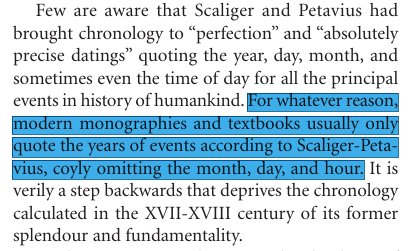The OL usage of K
ERSTEN with letter E instead of usual letter i (Chr
ist) seems to be
a real thing (more
here).
I do not know of any specific reasons to assume for the two Christian era letters to refer to any other eras than 803 and 1255 (Anno Domini system). Especially so as in the older letter Christianity is seemingly a recent affair and in the newer it's implicitly an established (non-contentius) part of the background. But let's for sake of argument assume there is some wonkery in the chronicles – I and others have noted shortening of time horizont in likes of Quran, Sanchuniathon, Norse sagas etc.

- Fomenko-History-Fiction-or-Science-bk1-ch1-note.png (52.89 KiB) Viewed 4843 times
If the Alarik or Alrik (ch. 19, MS 209: ÁL.RIK) at the very end of the book is equated with early 5th century Alaric I (Alarik), there are some fitting chronological matches not immediately apparent from OL narrative alone. The OL notes that in Alarik's days:
The other tribe that roamed closer by called them selves ‘Franks’, not because they were free, but because Frank had been the name of their first king. [...] The Gools did not know who he was, so he was later exchanged for a high-ranking Gool that Askar’s army had taken prisoner. [...] Meanwhile, the Magyars [top-level Finns] were traversing the lands of our neighbors more boldly than ever before. Near Egmond [Frisia], where the burg Forana had once stood, they built a temple, even larger and richer than Askar had built at Staveren.
The Frankish story is almost the same as reported in 7th century, or about 200 years later:
Again splitting into, two groups, half of them entered Europe with their king Francio. After crossing Europe with their wives and children they occupied the banks of the Rhine and not far from the Rhine began to build the city of "Troy" (Colonia Traiana-Xanten)
[source: Wikipedia on
Franks; for comparison the German city of Trier was known in medieval era as "
Babylon" and Norse sagas repeatedly as trope blend Troy/Turkey with Finland (perhaps via city of Turku/Turci)]
The Gools or Gallis of Gaul, of Celtic roots, were certainly
still around in the late 300s and early 400s. The Galli trans-sexual religion was at the time part of the Roman culture and there had even been a wannabe-trans emperor who paraded
a black stone, just as in the
original Galli religion (a theme later picked up by
Islam).
If we assume that the Finnish temple building at western continental Europe was succesful part of their larger operation, one would assume Finnish influences for later Germanic peoples of that same general region. For which we have both literary and DNA evidence. A notable theme in the Germanic culture of the same approximate region is the Beowulf and the Frisian-Danish battles. These are approximately dated at 6th century via the
Hygelac connection. Beowulf is descedant of
Wægmund or
Väinämöinen of Finns. A good match with Magus and the sage-seer class constituting the Magyars. Maybe even the part about swimming in seas and being cast ashore "on Finna land" (Beowulf line 580) is a direct reference to the similar
Finnish-Frisian-Egyptian swimming themes of Väinämöinen or Wenamun. Combined with the previous and OL one can even wonder if the
Finn of Finnesburg means 'Finn' of 'Finn-castle', half-Frisian and half-Finnish ruler in Frisia..? Then we have also the DNA evidence:
However, we also see ancient Swedish-like and Finnish-like ancestry in the westernmost fringes of Europe, and Danish-like ancestry in the east, defying modern historical groupings
[source:
Population genomics of the Viking world]
Timewise this is, post-Alaric I and pre-Viking era, a perfect match with OL narrative.